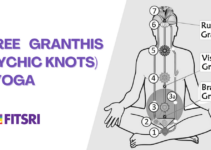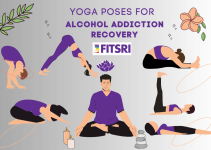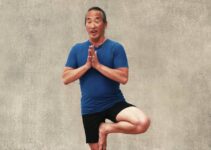- Restorative Yoga Basics
- How it’s different?
- Effects on nervous system
- Benefits
- Before you begin practice
- Poses you can try
- What to expect in class?
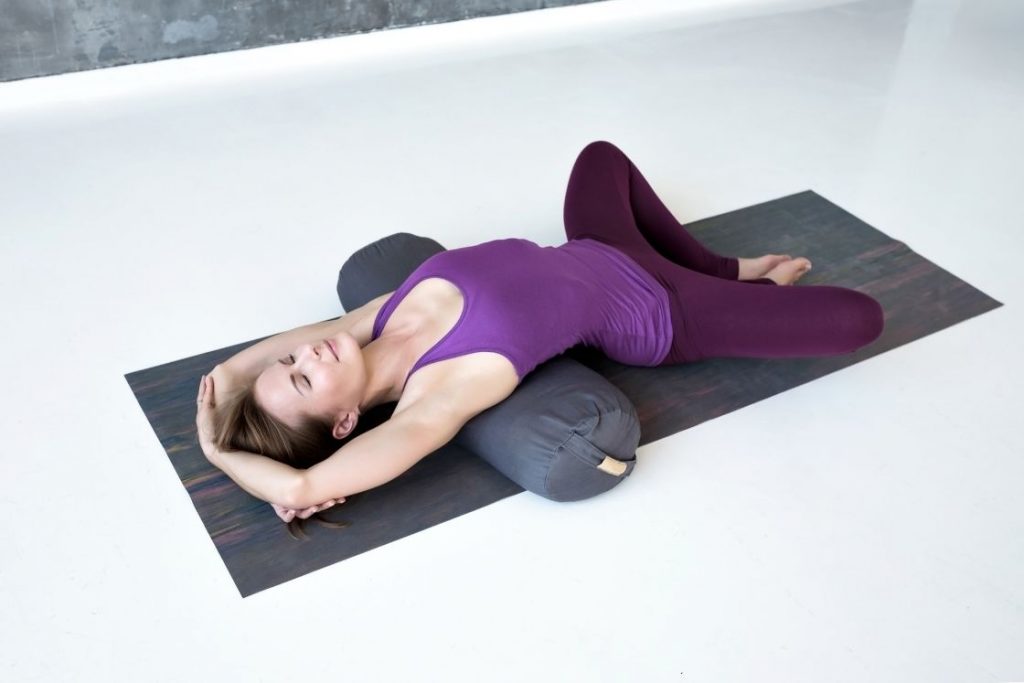
Have you ever noticed yourself grinding your teeth during your sleep? Or experienced sudden fidgeting, restlessness? Maybe you have woken up to find your hands in a tight fist? These are all signs of the accumulated tension and stress in your body which it wants to release.
This stress can be a cause of multiple physical and mental problems in your yoga. Restorative Yoga helps in releasing this tension and ‘restores’ the harmony of the mind-body-spirit.
Just like meditation, in restorative yoga, you are working on allowing your body to rest and energize itself. The uniqueness of restorative yoga is that each pose is held for a long duration and you use a lot of props to keep still and let the stillness work its magic. It can be practiced by anyone under any setting, as long as you are creative in using things as props for support.
What is Restorative Yoga?
Restorative Yoga is a relaxing and calming yoga style that provides a healing effect to your body. It may appear passive and easy to practice but the stillness you need to hold the poses for an extended time is the main challenge.
You must remember that you are not performing this yoga to generate heat or stretch your muscles. You are giving your body a break and letting it heal itself.
When you practice restorative yoga, you use multiple props such as bolsters, cushions, straps, blankets, blocks, chairs, walls, etc to support your body. This is because you will be staying in a pose for as long as 20 minutes and these props will support your body in a way that you can’t.
Another important factor here is that if you are suffering from a chronic illness or are recovering from an injury, practising restorative yoga can help in the healing process by making your body rest.
Do not be surprised if you find yoga classes offering only 4-6 restorative yoga asanas. Since you are spending time setting up the supports and then relaxing your body in a pose for 5-20 minutes, you will not be able to practice many poses.
How is Restorative Yoga different from other yoga styles?
Yoga styles such as Hastha, Vinyasa, Hot Yoga encourage inner heat generation by holding poses for a lesser time and performing them in a flow. Restorative yoga requires you to stay in a relaxed pose for more than 5 minutes. There is no heat generation which is why you are often required to cover yourself with a blanket or practice it in a cosy place.
It is also quite common to confuse restorative yoga with Yin yoga as both are relaxing. However, Yin Yoga emphasizes the stretching of connective tissues rather than muscles.
Even though restorative yoga takes its inspiration from Iyengar Yoga in the use of props, however, the purpose of their usage is slightly different. In Iyengar yoga, you are using props to support and align your body in a posture for balance and variations to the traditional yoga poses. Whereas restorative yoga uses props to support the body to relax and surrender.
The effect of Restorative Yoga on your Nervous System
One of the main reasons Restorative yoga is sought after is due to its positive effect on the nervous system. This style of yoga is extremely effective in activating the Parasympathetic Nervous System (PNS)
PNS forms a part of the Autonomic Nervous System, which is responsible for controlling involuntary functions like heart rate.
The Sympathetic Nervous System (SNS) and Parasympathetic Nervous System (PNS) are part of the Autonomic Nervous System. While SNS activates the “fight or flights” instincts during periods of stress or emotional trauma, PNS is responsible for the “rest and digest” mode after traumatic or emotional incidents.
SNS, at a moderate level, is necessary and acts as a driving force to overcome situations such as a job interview, entrance exams, addressing a large audience, or even asking someone out for a date. However, when stress and anxiety cross the danger mark, imbalances such as poor digestion, improper sleep, hormonal imbalances, etc may occur in the body.
This is where the work of PNS comes in. Restorative Yoga will aid in strengthening the shift from the state of stress to a state of rest. It will reconnect us with our Parasympathetic Nervous System through relaxing poses and reduce the output of cortisol (stress hormone).
When the PNS gets activated, it will guide you to come back to your normal routine by making your organs work the way they should, by getting your body in a state of rest. It also improves your sleep quality, reduces muscle tension, improves the function of the immune system, etc.
Benefits of Restorative Yoga
Though the essence of this yoga style may be slightly different from the traditional yoga style, its benefits are the same. There have been some studies conducted to look at the benefits of restorative yoga.
A study published in 2017 noted that when African-American women, who were breast cancer survivors, practised restorative yoga for 8-weeks, it had a positive effect on a decrease in the level of depression within them.
Another study was conducted on Japanese nurses who worked night shifts. They performed restorative yoga for 4 weeks at home and 4 weeks of common stress-relieving methods. It was noted that the group that practiced restorative yoga showed a significant decrease in psychological and physical occupational stress.
Yet another study shows that restorative yoga was successful in reducing weight and subcutaneous fat (present just under the skin) in women who have a BMI of 30 or more and are considered obese as per the Centers for Disease Control and Prevention (CDC) standards.
It is quite obvious that there are still gaps in scientific studies, it cannot be ignored that restorative yoga has proven to be effective in alleviating symptoms of depression, stress and helped in reducing weight.
Some other benefits are:
- It can strengthen the connective tissues around the joints and bones.
- The yoga style is a great way to reduce stress and anxiety which help in keeping a better mood.
- Since this style of yoga promotes relxation and induces a state of rest for the body, it aids in improving sleep quality.
- Restorative yoga can be used as an alternative care for recovery from injury, hence reducing pain in the bones, muscles, tendons, ligaments and soft tissues.
- It helps in activating the Parasympathetic Nervous System by relaxing and soothing the nervous system.
- By reducing cortisol, it aids in improving the overall wellbeing of the mind and body.
- Due to the usage of props, pregnant women can easily modify the pose as per their comfort.
- It is required that you maintain a pose for as long as 15-20 minutes which requires dedication, concentration, courage and compassion. This enhances self-awareness and also promotes mindfulness.
- Restorative Yoga encourages your body to rest, which is of great help to our immune system.
Tips to remember before starting Restorative Yoga
- Practice the poses in a quiet place. Sudden movements or disturbances will cause your body to go into a Sympathetic state. The relaxation you are aiming to achieve will not be possible with noises and distractions.
- When the body gets relaxed, its temperature tends to go down. Hence it is advisable that you keep some blankets near you or wear an extra layer of clothing.
- While practicing the pose, it is better to keep your eyes closed. This helps in relaxing the mind as well as keeping still. You can also use an eye pillow or a sleeping mask to aid in this.
- More often than not a slight weight on the body such as back, chest, stomach, or pelvis helps in getting the body to relax. You can use a sandbag or a heavy folded blanket to put weight on the part you feel will help you.
- While common props such as blocks, straps, bolsters, and cushions are available in yoga classes, you can use alternatives using things easily available at home. For example, you can use a rolled towel, belt, chair, rolled blanket, walls, books, pillows, etc when practicing Restorative Yoga at home.
- It is quite common for a person to fall asleep during such a session. To avoid this, you can place a timer near you which you set for 10-15 minutes, as this is the average time for relaxation.
Restorative Yoga poses you can try at home
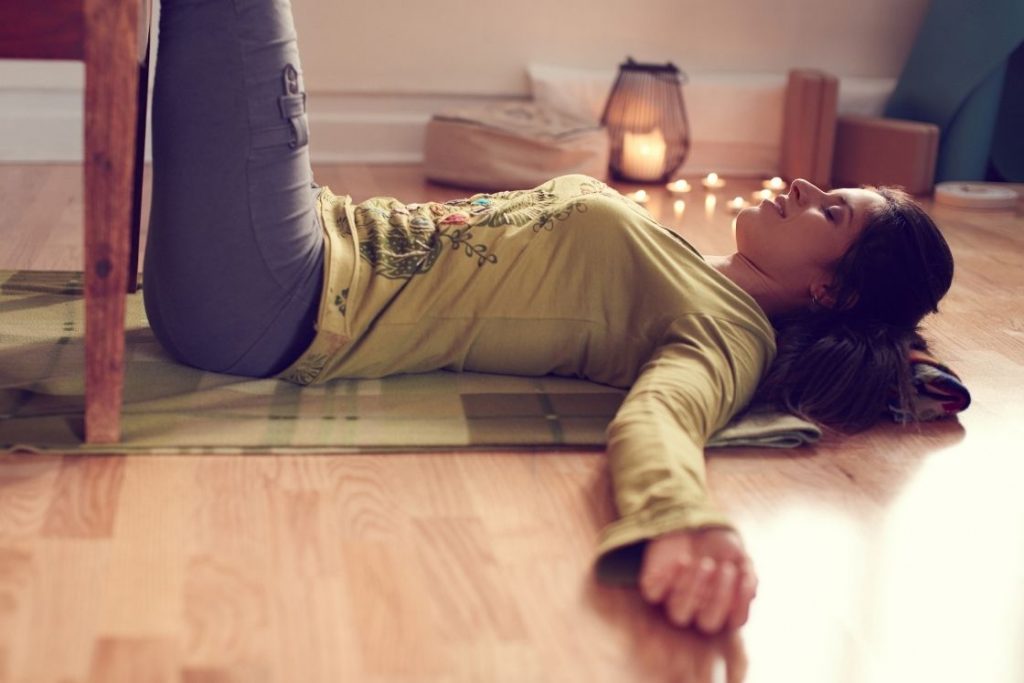
Once you have learned the correct way to practice the poses and use the props in a class, you can easily do some of the poses in the comfort of your home. All the poses listed below should be performed for at least 5 minutes and can be extended up to 30 minutes.
We have listed 6 easy and relaxing poses that you can practice at home with the help of props that you can easily find.
Child’s Pose (Balasana)
Child’s pose is one of those poses that help you release all the stress and tension of your body, especially in the area of your back and hip. The pose aids in relieving the fatigue and when support is used, any aches in your neck and back will also be gone.
To perform this pose, sit in a Vajrasana with your buttocks placed on your heels. Place a bolster, lengthwise in front of you. You can also place a cushion under your thighs to elevate your hips and aid in keeping balance.
As you exhale, bend forward slowly resting your torso and head on the bolster. You can keep your arms beside you or stretch forward. To support your arms, keep cushions or folded blankets/towels under your forearms. As for your head, keep alternating between both cheeks for a few minutes each to avoid a stiff neck.
Bridge Pose (Setu Bandhasana)
The bridge pose is considered an intermediate to advanced pose, depending on your expertise. You have to engage your hamstrings and core muscle to raise your hips off the floor. This pose gives a great stretch to the glutes, elongates and strengthens the spine, and opens your chest and hips.
However, this active backbend pose can turn relaxing and passive with the use of props such as cushions, books, or blocks.
Lie down on your back and spread your legs hip-width apart. Bend them at the knees, place the feet firmly on the floor and keep your hands by your side. Engage your hamstrings and lift your hips off the floor. Slide a block, stack of books, or one to two cushions under the hips such that your lower back and tailbone are fully supported.
Once you have completed your practice, lift your hips to remove the prop, slowly bring your hips back to the floor, and straighten your legs.
Legs-up-the-wall Pose (Viparita Karani)
This pose in itself is a very relaxing pose that increases the circulation in your body. By placing your legs on the wall, your hamstrings and back of the neck are gently stretched. It is also a great way to relieve tiredness in your legs and feet.
For this pose, you can add support under your neck or hips.
Begin by placing a folded blanket/towel in the middle of the yoga mat. Sit with your right side against the wall and swing your legs to place them against the wall. Keep your buttocks as close to the wall, as per your comfort. Completely lie down and place your head on the folded blanket/towel.
You can also place a cushion or blanket under your lower back to give an inversion to this pose.
Seated Forward Bend Pose (Paschimottanasana)
The pose essentially helps in spinal decompression and also stretches the back of the neck. By using supports for this pose, you can stay in this extension pose without discomfort for as long as you want. You can use a bolster or folded blanket for your upper body and head.
Sit in a yoga mat with your legs together and stretched in front of you and your back straight. Place the bolster/folded blanket or towel on your legs. Fold forward from your hips and place your torso and head on the prop.
In case of a blanket/towel or bolster keep alternating your cheeks. If you are using blocks, place blocks at an equal distance so that the weight of your torso and head is spread equally.
Another way to use props is to keep the folded blanket/towel under your knees and blocks at a distance where you want to stop bending and rest your forehead.
Fish Pose (Matsyasana)
Along with being a great chest and hip opener, it is a pose that is best suited for people with desk jobs. It eliminates shoulder and neck pains, elongates the spine, and relaxes the upper back. With the use of a bolster or folded blanket/towel for your neck and back and an eye pillow (optional), you can get a great pose that will make your stress go away.
If you want you can use blocks however the corners may start digging into your back, which will defeat the purpose of the yoga session.
Place two bolsters or folded blankets/towels parallel to each other in a way that they target your shoulder blades and your head. With your back to the props, lie down on them slowly. You can remove the support under your head if you feel that you will be able to hold the pose with your head hanging for a long time.
You can fold your legs at your knees and join your feet at the soles. For enhanced support, place cushions under both knees. Your hands can either be stretched overhead or placed beside you. Another alternative is to place spread them on the sides or bend them at the elbow.
Relax your body in this pose by taking slow deep breaths.
Corpse Pose (Savasana)
The Savasana is the ultimate relaxing pose that is generally performed at the end of any yoga session or in transition between poses. In this pose, you tend to feel all the sensations post a yoga session and release all the tension of your mind and body. It may seem a simple pose but keeping still is one of the biggest challenges.
With added support, you can easily transcend into a deep state of tranquility!
Place a bolster on one end of the mat and a folded blanket/towel on another end. Lie down so that the back of the knees is supported by the bolster and your neck and head come on the blanket. Place your hands on your chest, at your sides, or spread outwards, whichever position feels comfortable to you.
In this position, you can also add slight weights on your thighs, belly, pelvis, or chest through a sandbag or a heavy folded blanket.
How does a typical Restorative Yoga class look like?
Now that you have understood the basics of Restorative Yoga, here is a brief on what to expect in a yoga class.
In the beginning, you may perform a slow breathing pranayam to get your mind and body to relax. The instructor will let you know the kind of props that you will need for the session and may also tell you the number of poses you would be performing.
You can also expect the instructor to play soft relaxing music and dim the lights to induce a relaxing and calming environment.
You should always keep an extra layer of clothing such as a sweatshirt or socks with you because there is a high chance of you feeling a little cold during the session. You can also use blankets to cocoon yourself while practicing a pose.
Depending on the duration of each pose, you will be performing 5-6 poses for the duration of 75 to 90 minutes of class.
Your teacher will guide you into the poses, make you focus on your breathing, and sometimes instruct you through a meditative state. Even if you fall asleep, do not worry. This only means that your Parasympathetic Nervous System has been activated.
At the end of the session, you may perform a quick meditation or take a few deep breaths to make you aware of the release of the stress from the body. You will feel light and refreshed as if a weight has been lifted.
Conclusion
Just like you need a vacation to de-stress, your body also requires a time-out. Restorative Yoga can be a vacation to your body. Though it may be for only 1-1.5 hours per day, its effects will be seen for months to come. Dedicate some time to nurture and love your body and mind, they will surely thank you for the effort that you have put in.
